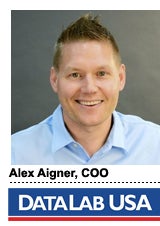 DataLab USA, a boutique analytics firm that works mostly with financial services and insurance companies, is betting on advancing addressable TV through customized algorithms.
DataLab USA, a boutique analytics firm that works mostly with financial services and insurance companies, is betting on advancing addressable TV through customized algorithms.
“Our role in the data world is to aggregate all the aggregators,” explained Alex Aigner, DataLab Digital’s COO. “We’ve commoditized how we build custom algorithms. Whether those algorithms are used for banner ads or for addressable TV, it’s the same methodology.”
DataLabs USA’s largest clients include Citibank, Travelers, Farmers Life, Allstate, Hughes Communications and OneMain Financial. In the telecommunications space, the firm works with T-Mobile. According to Aigner, DataLab’s clients spend at least $10 million in marketing efforts.
AdExchanger spoke to Aigner about DataLab USA’s approach.
AdExchanger: What problem do you solve for your clients?
ALEX AIGNER: The way we work on addressable TV or radio is through subscriber files. We can score any household in order to figure out the likelihood they’ll become a customer. For the major MSOs, we receive their footprint of customers every month or two months flagged with whether or not a household supports addressable TV. We hash that information and overlay a customer score that’s within a 5% prediction of conversion likelihood. We then return that to the client, who can execute media buys off those analytics.
How does that differ from how most firms buy addressable TV?
I’ve talked to CEOs of agencies who are buying media on television based off segmentation of channels or basic demographics. We have clients going directly to MSOs without the agency and buying media. We’re not selling media, we’re selling intelligence.
For example, T-Mobile is a customer of ours and we maintain their CRM database. They’ll source a prospect score from us, whether it’s email or direct mail. Acxiom tried coming in with a switcher model, which can signal whether someone’s with Verizon and looking to switch to T-Mobile. But Acxiom is selling that solution to an entire industry. We build custom solutions for each of our clients.
Do you write custom algorithms for each client?
Yes. We once had a project where we delivered a new algorithm to Citigroup every four days, which was intense. All the addressable TV companies license national files. If advertisers go to them and want to reach 20 or 30-year-olds, they can do it themselves. But they don’t have the ability to offer custom algorithms for clients overlaid on top of a subscriber file.
AdExchanger Daily
Get our editors’ roundup delivered to your inbox every weekday.
Daily Roundup
What goes into customizing an algorithm?
The average baseline of an algorithm can be built in a day, or even in four hours. Then it takes three to four weeks to do incremental lift. But algorithms and models are disposable. After you build an algorithm you should always be changing it. You should constantly be loading first- and third-party data into it. That means that a lot of what we do is data mining. Anyone can build models or buy software, but 75% of the job is preparing the data, not building the algorithm.
Most people will just take into account income, age and gender. We’ll also look at something like home value divided by car value. That’s a derivative score, which could mean something or it could not, but we do the modeling to figure out if that information offers incremental lift.
Can you give me a real-world example?
An insurance client was looking to boost actual completed sales, not increase insurance quotes. We mined data to figure out consumers’ “X” dates [the day insurance coverage will expire]. Then we built an algorithm off of the state filings of insurance companies, to signal if consumers would actually be quoted a comparable insurance rate. If Geico quotes me at $2,000, for example, and I currently have a $500 policy with State Farm, why would I switch? We used an algorithm to predict the actual policy premium. If it didn’t meet the competitor’s price, then it wouldn’t help our KPI of a completed sale.
What can you say about revenues or growth?
We are a privately held company. Fifteen years ago we were 20 people and we’ve grown to 75. Our business model is to work with large, sophisticated marketers who need intelligence and analytics. We help grow their prospecting, and our data growth doubles every year. That’s how we grow financially.
What’s on your radar for the next 12 months?
Right now it’s addressable television. We have 45 million households we assess addressable television for and we have a road map of 90 million. We have clients that want to go into more addressable television, but the MSOs don’t have all the technology yet, so that’s one limitation we’re facing.
Addressable radio is also of great interest to us, and we’re trying to branch out of the insurance space and work with some of the largest financial companies. We’re now in the telecommunications space and we’ve also recently broken into hospitality and travel. We’ve been working with TubeMogul and similar companies on pre-roll efforts. But the sector we’re going after next is retail.













